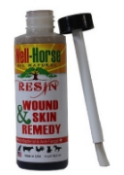Abscess
A hoof abscess can be caused by various reasons such as invasive thrush, trauma, invasive debrie, gravel, etc. Usually an abscess will start in the bottom (sole-solar) of the hoof and will travel upwards.
Invasive Thrush or pathogenic bacteria trapped under the bars of the hoof is a common denominator in the making of an abscess. This invasive bacteria will be pushed upward by outside forces everytime that the hoof engages with the ground untill it reaches the sensitive laminae. the sensitive laminae is the live/raw/bloody part of the inner hoof. The body of the horse will start rejecting the foreign object by creating and releasing end fluids or pus. The fluids surround the affected area to fight the infection. These fluids will also create a hydraulic pressure to try to push the object out of the body.This hydraulic presure against the sensitive laminae will cause a lot of pain and therefore acute lameness of that limb.
Foreign objects become trapped between the strong tissues of the sole, hoof wall, and coffin bone(P3). Consiquently, the only way for the object to travel is up to the coronary band which consist of softer tissue and is therefore penetrable. Once the foreign object reaches the coronary band the hydraulic pressure will cause the object to burst anywhere from 1/4 to 3 inches along the coronet releasing all this pressure in minutes. Improvement of the lameness is almost immediate.
This process will take anywhere from 1 to 3 weeks. After a few weeks you will notice the burst blow as a horizontal crack in the hoof growing down. This scar or crack is not a threat to the health of the hoof because the crack is horizontal to the ground and not vertical. Vertical cracks are dangerous. Also, the hoof has a very fast healing process so the inside is already sealed in. If your horse is bare foot,you may want to consider putting shoes when the scar/crack gets about one inch from the ground to give better and even support for the load.
How to treat an abscess 101
The symtoms usually started overnight. The horse is dead lame in that limb,the hoof is warmer than the other three and you call the Vet and Farrier imediately.
Only an experienced Vet or Farrier can deal with this issue because invading the inside of the hoof is major leagues, folks.
You start by running pressure with the hoof testers in various points of the hoof including the toes, quarters and heels. then wait for the horse to respond by flintching when pressure is applied in the affected area. Usually there is a little window that you can follow with an invasive tool from outside the sole to the very inner part of the laminae to where the abscess is located and pop it, releasing the hydraulic preassure that I explained before. Bleed the wound for a while and soak it in warm water with two handfulls of magnesium sulfate (epsom salts) for 20 minutes. Clog the hole with a cotton ball soaked in Thrush-Off, seal the cotton with pine tar and put a shoe with a pad filled with a poltice such as Antiphlogistine or Ichtamol and you should be ready to go.
On the other hand if you can't find a Vet or Farrier that can do this invasive procedure or don't want to do this, You can treat it yourself by following this steps :
Soaked the hoof in warm water and epsom salts for 20 minutes for better resolution.Smear antiphlogistine or Ichtamol poltice on the bottom and outside the hoof capsule,wrap with thick cotton,then wrap with sarran paper,then wrap with vet wrap and finally with duct tape for outside protection.Repeat this every 3 days until the abscess follows the course and burst up in the coronet.
Always consult with a Vet or Farrier before you take charge; Accurate diagnosis and proper handling is key to success.





